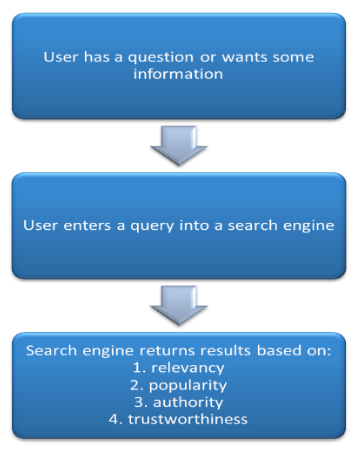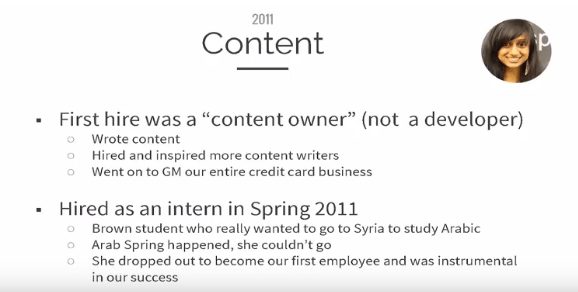October 21, 2016
How To Improve Organic Search
The story behind NerdWallets Organic Search Strategy (that brings in millions of visitors a month)
They rank #1 for “best credit cards”. They were already bringing in millions of visitors each month before any fundraising. They’re now valued at over $520 million, with revenue expected to top $100 million annually. And yet just a few years ago, NerdWallet was another fledgling upstart created by two childhood friends. Here’s what happened.
NerdWallet’s inauspicious beginning
In 2008, Tim Chen was a freshly laid off hedge fund analyst, spending his days at Dave & Buster’s because, “They have half-price tickets on Wednesdays”, he told Inc. His childhood friend and eventual NerdWallet co-founder, Jake Gibson, survived the lay offs from JPMorgan Chase during the Great Recession. The two met years earlier in a math and science school in Atlanta. Which apparently is now a hotbed for producing awesome—bootstrapped!—tech talent like NerdWallet and MailChimp. The epiphany for Tim’s next move came when those around him, including his sister and parents, began asking him for advice on basic personal finance questions like credit cards or mutual funds. Transparency, and providing unbiased financial advice to “normal” consumers (read: those without six digit net worths) didn’t really exist in the ashes of the subprime meltdown. Cue the long slow slog from $800 bucks and ideation to MVP, pivots, and iteration. Eventually, Tim and Jake stumbled upon a promising revenue stream that still makes up the brunt of NerdWallet’s business: credit cards. The majority of personal finance shopping and comparison—like most similar industries these days—is happening online. Banks pay lucrative finder’s fees or commissions to sites that deliver new credit card applicants. eMarketer predicts this digital advertising from top banks to hit $10 billion soon. The math then, is relatively simple. NerdWallet can reportedly earn up to “hundreds of dollars” for each site visit. Apparently five percent of the people who read about one of these credit cards online will eventually buy the product. In other words, the click through rate is good. The conversion numbers are decent. And each site visitor has a quantifiable value. The kicker then—the only thing holding a business model like this back—is the number of people you can get to the site in the first place. The problem is that paid acquisition, which is a commonly predictable and lucrative customer acquisition channel when done correctly, is prohibitively expensive in this vertical. So in this case, it wasn’t as simple as “turning the faucet on or off.” Besides, NerdWallet wasn’t venture backed and sitting on piles of cash to burn in their early days. As a bootstrapped company, they had to keep the cost of customer acquisition as low as possible. Despite all this, NerdWallet doubled and tripled traffic in the first few years to millions of visitors each month. Here’s how they did it.
How NerdWallet created their own massive audience
Despite starting in 2008, by the end of 2009 NerdWallet only had 283 users, according to a Hustle Con talk years ago. That sounds more like your family and friends on Facebook. Not a multimillion dollar rocket ship now raking it in. In 2010 though, they jumped to 38k. Then 150k in 2011. The scale kept going, to 480k then 1.3m and over 2.2m in 2014. What happened?
1. Fine tune your value prop
From Day 1, NerdWallet sought to differentiate themselves based on transparency. Simple? Sure. Obvious? You’d think so. But this is Wall Street we’re talking about, where “greed is good” was created. As opposed to the way some businesses shell out recommendations for a single bank’s big financial vehicles (and thus receiving a big cut), NerdWallet receives small cuts across many different companies. Their goal, along with a sales link, is to provide as much independent information as possible to inform users of the pros and cons behind each product.  In other words, while most media-driven companies in the financial world provide biased information, NerdWallet is the trusted third party. That crystal-clear vision (if nothing else at the time) helped them create a unique selling proposition people could believe in and get behind, allowing the promotional messages and other tactics to take hold.
In other words, while most media-driven companies in the financial world provide biased information, NerdWallet is the trusted third party. That crystal-clear vision (if nothing else at the time) helped them create a unique selling proposition people could believe in and get behind, allowing the promotional messages and other tactics to take hold.
2. Find your “flywheel”
PPC couldn’t work. Pitching journalists was tremendously difficult in the early goings. And the ever elusive word of mouth was non-existent in their humble beginnings. But over time, SEO did—starting with a slow crawl until finally providing the scale it’s known for in subsequent years. SEO, while technically difficult, incredibly time consuming and glacially slow moving, is also one of the best scaling channels; providing compounding benefits not unlike compounding financial returns.  NerdWallet excelled in the early days by recognizing this as their best shot at success, and then doggedly pursued an SEO process with everything they had. In 2011 they boiled it all down to:
NerdWallet excelled in the early days by recognizing this as their best shot at success, and then doggedly pursued an SEO process with everything they had. In 2011 they boiled it all down to:
- Build quality links
- Create quality content
While that sounds trite, they recognized that there was no way to game the system and instead simply committed to doing the hard work necessary to create a marketing flywheel and eventually stand out in a crowded online consumer finance space (that already included content stalwarts like The Motley Fool). Despite recent algorithm updates and changes, search engines still work in largely the same way and help to make sure the best of the best rises to the top. 
3. Focus your (limited) resources
NerdWallet also began focusing exclusively on these efforts to the exclusion of other ones, only pursuing specific tactics (like PR) if it supported their primary objective too. Even product design—arguably step #1 for most consumer startups today—took a back seat in the early days. In the Hustle Con talk, Tim expounded on the extreme importance of “defining exactly what you need to win”: “Early on, we realized the need to build 500+ quality content pieces and links a month in order to gain scale. This forced a radical rethink of where to aim the organization.” They were also smart enough to realize that the founder’s time was the most limited resource. So they did what every Silicon Valley playbook recommends next—hire developers first. Just kidding, they made a content marketer their first hire.
They doubled down on this by making their first big investment a PR company, spending their first monthly revenue to generate press and high quality, editorial backlinks to their site. Today, a significant portion of NerdWallet’s 285 employees are ex-journalists. The have a newsroom, complete with an Investigative Journalist team led by former Pulitzer Prize winners. These aren’t BuzzFeed-esque, clickbait millennials churning out top ten listicles, but old-school pros capable of doing in-depth features and analysis based on years and years of experience. All of that lends credibility, professionalism, and transparency—which perfectly aligns with the company’s core vision and objectives from the outset.
Conclusion
The tactics are out there. All the tips and tricks and hacks you can handle. But the tough part, and what makes companies like NerdWallet huge successes, is commitment and persistence over time. All tactics can work to one degree or another. SEO is anything but sexy these days, but NerdWallet proves it can still build a big business. It was just 5+ years in the making.




 (
(








